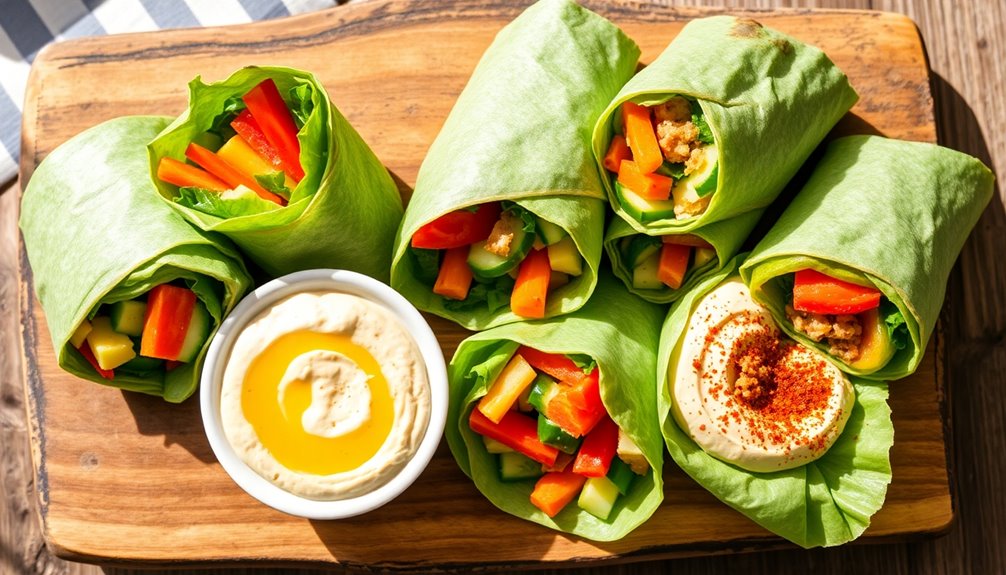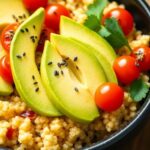Veggie wraps with hummus are a nutritious and tasty choice for any meal. They're packed with essential vitamins and minerals from fresh veggies like spinach and bell peppers. Spreading hummus on a tortilla not only adds flavor but also healthy fats and protein. You can customize your fillings with various vegetables, cheeses, and even seeds for added texture and taste. Consider experimenting with different hummus flavors, like roasted red pepper, to keep it exciting. Plus, these wraps can accommodate dietary needs with options like gluten-free tortillas or lettuce leaves, making them versatile. You'll discover even more ways to enhance your wraps.
Key Takeaways
- Use large tortillas or lettuce leaves as wraps, spreading hummus to add flavor and moisture while preventing sogginess.
- Fill wraps with a variety of fresh veggies like spinach, bell peppers, and carrots for essential vitamins and minerals.
- Experiment with different hummus flavors, such as roasted red pepper or spicy harissa, to enhance the taste of your wraps.
- Garnish wraps with toppings like feta cheese, sunflower seeds, or fresh herbs for added flavor and nutrition.
- Serve veggie wraps with sides like fruit salad or quinoa for a balanced and satisfying meal.
Benefits of Veggie Wraps
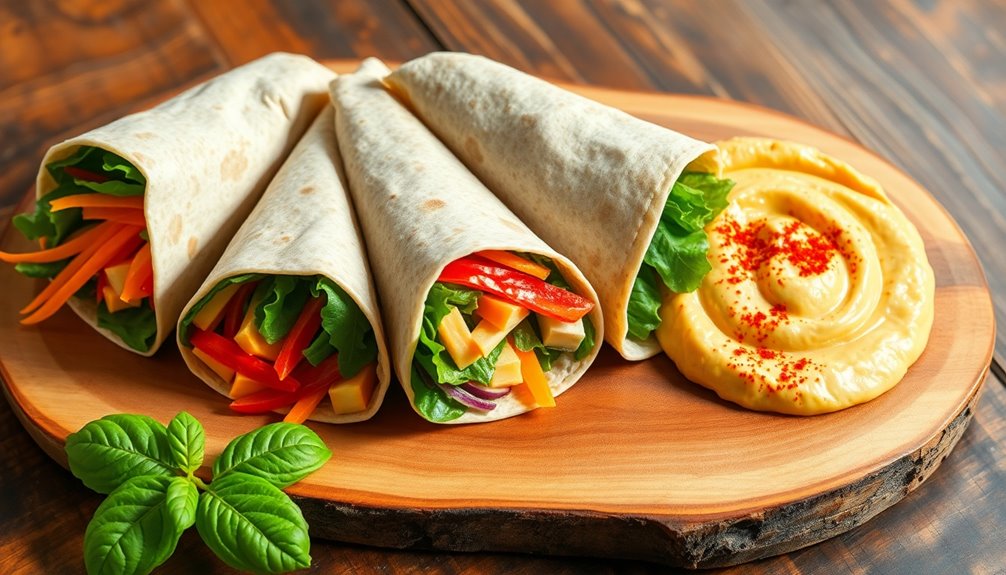
Enjoying veggie wraps comes with a variety of health benefits that can enhance your diet. These wraps are packed with an array of colorful vegetables, providing rich nutritional value. Vegetables like spinach, bell peppers, and carrots aren't just visually appealing; they're also loaded with essential vitamins, minerals, and antioxidants that support overall health.
One of the standout advantages of incorporating veggie wraps into your meals is their potential for weight loss. Since they're generally low in calories but high in fiber, they can help you feel fuller for longer, which may reduce your overall calorie intake.
When you combine these wraps with healthy fats or protein, like hummus, you increase their satiating power while still enjoying a delicious meal.
Another appealing aspect of veggie wraps is the endless flavor combinations you can create. From zesty lemon-tahini dressings to spicy sriracha, you can customize each wrap to suit your taste preferences, making healthy eating enjoyable and varied.
This flexibility allows you to explore new ingredients and flavors, keeping your meals exciting and preventing dietary boredom.
Essential Ingredients
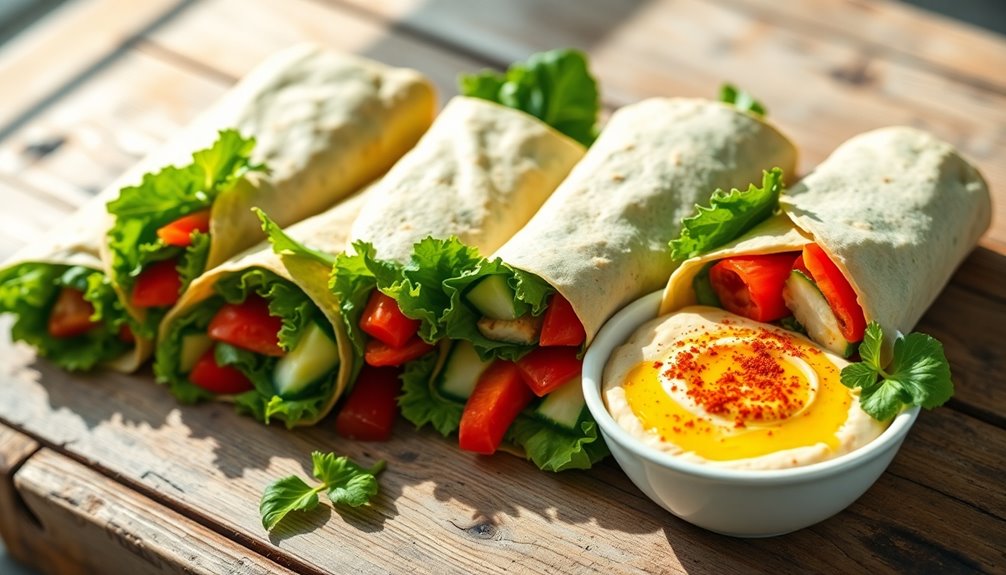
When preparing veggie wraps, the choice of crucial ingredients can greatly impact both flavor and nutrition. By selecting the right veggies, spreads, and additional toppings, you can create a delicious and satisfying meal that meets your nutritional needs.
Here's a quick guide to help you choose the best ingredients for your wraps:
| Ingredient Type | Examples | Nutrition Facts |
|---|---|---|
| Vegetables | Spinach, Bell Peppers, Carrots | Low in calories, high in vitamins A and C |
| Spreads | Hummus, Avocado, Greek Yogurt | Good source of healthy fats and protein |
| Toppings | Feta Cheese, Sunflower Seeds, Fresh Herbs | Adds flavor, texture, and essential nutrients |
Incorporating a variety of vegetables not only enhances the flavor combinations but also boosts the overall nutrition of your wraps. For instance, spinach packs iron and magnesium, while bell peppers are rich in vitamin C. Utilizing spreads like hummus provides a creamy texture and adds protein, making your wraps more filling.
Toppings like feta cheese can introduce a salty bite, while sunflower seeds contribute crunch and healthy fats. Each ingredient plays a crucial role in creating a balanced meal that satisfies both your taste buds and your nutritional needs. By being mindful of what you include, you can enjoy fresh, flavorful veggie wraps that you'll feel good about sharing with friends and family.
Types of Hummus
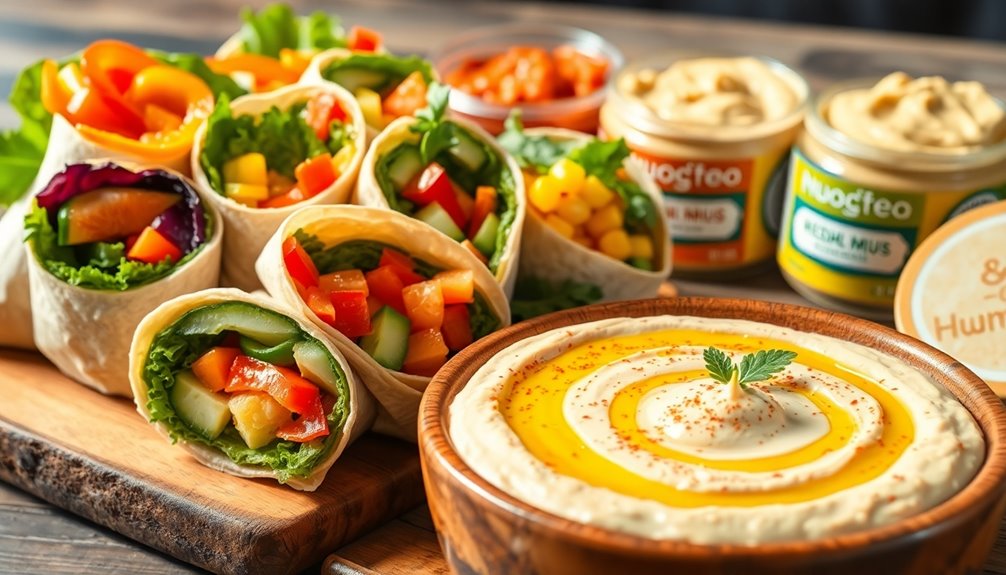
Hummus serves as a fantastic spread for veggie wraps, and there's a wide variety of types to choose from, each offering unique flavors and nutritional benefits. Traditional hummus, made primarily from chickpeas, tahini, lemon juice, and garlic, provides a creamy texture and a rich source of plant-based protein. It's a classic that pairs well with a multitude of veggies, making it a go-to choice for your wraps.
You might also explore different hummus flavors to spice things up. Roasted red pepper hummus adds a smoky sweetness, while garlic or spicy harissa versions can kick your wrap up a notch. These variations not only enhance taste but also provide additional nutrients. For instance, beet hummus not only boasts a vibrant color but is also high in antioxidants.
When it comes to hummus pairings, consider the veggies you're using. Crunchy cucumbers and bell peppers complement traditional hummus beautifully, while spicy varieties might pair better with milder veggies like avocado or zucchini. You can even use hummus as a base for a Mediterranean wrap, incorporating olives and feta for extra flavor.
Don't forget about bean-based or nut-infused hummus options, like black bean or almond hummus, which can cater to different dietary preferences and add new dimensions to your wraps. By experimenting with various hummus types, you can create satisfying veggie wraps that not only taste great but also foster a sense of community and shared enjoyment at your table.
Step-by-Step Preparation
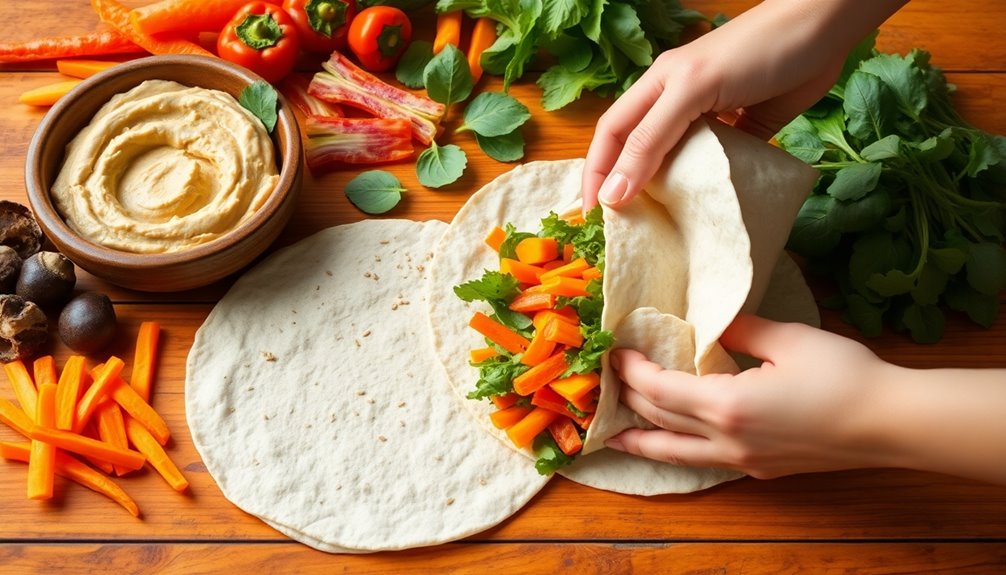
How do you create a delicious veggie wrap with hummus? Start by gathering your ingredients. You'll need a large tortilla or wrap, your favorite hummus, and a variety of fresh vegetables. Common choices include spinach, bell peppers, cucumbers, and carrots. Feel free to mix and match veggies to suit your taste; this is where your flavor combinations come into play.
Next, spread a generous layer of hummus on your wrap. This not only adds flavor but also acts as a barrier to keep your wrap from getting soggy.
Now, it's time to layer your veggies. Place them in the center of the wrap, leaving some space at the edges for easy folding.
Now, let's discuss wrapping techniques. Start by folding the sides of the wrap inward to contain the filling. Then, start rolling from the bottom, tucking the filling in as you go. The key is to keep everything tight without tearing the wrap. Once you reach the top, seal your wrap by lightly pressing it down.
For a clean cut, use a sharp knife to slice it in half.
Creative Filling Ideas
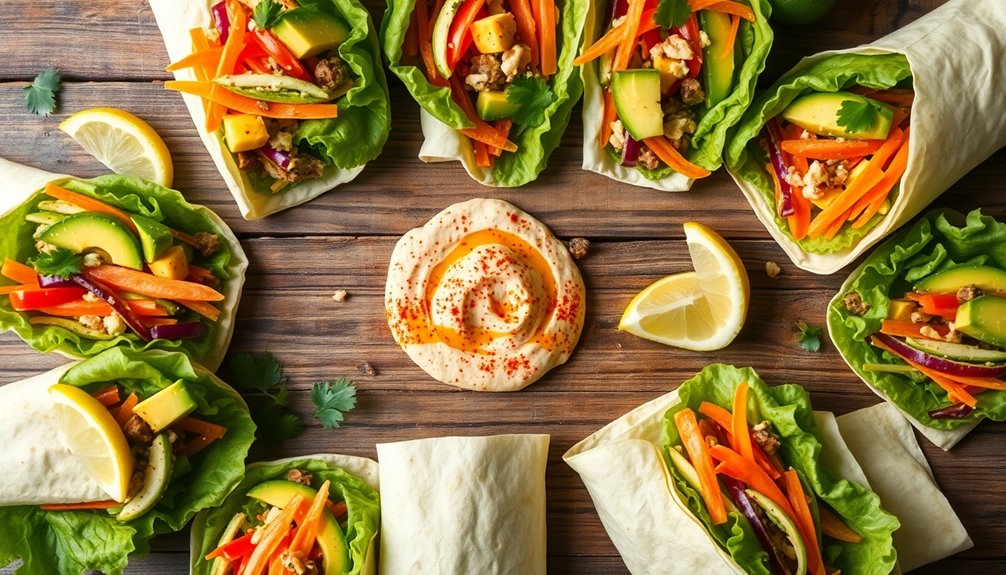
After mastering the basic technique for wrapping your veggies, it's time to explore some creative filling ideas that can elevate your veggie wrap experience. You'll find that experimenting with various flavor combinations not only adds excitement but also caters to diverse taste preferences.
For instance, try pairing roasted red peppers with a tangy feta cheese or mixing fresh basil with mozzarella for an Italian twist.
Don't hesitate to contemplate ingredient substitutions, too. If you're out of hummus, a creamy avocado spread can work wonders. Or, swap out traditional lettuce for peppery arugula, which adds a unique bite. These small changes can create a delightful surprise in each bite.
Cultural influences can also inspire your wraps. Think about adding elements from Mediterranean, Asian, or Mexican cuisines. For example, a blend of shredded carrots, cilantro, and a splash of lime can give your wrap a zesty kick reminiscent of fresh spring rolls.
When it comes to presentation tips, remember that we eat with our eyes first. Layer your ingredients artfully, and ponder using colorful veggies to create a vibrant visual appeal. You might even sprinkle some sesame seeds or crushed nuts on top for added texture.
Serving Suggestions
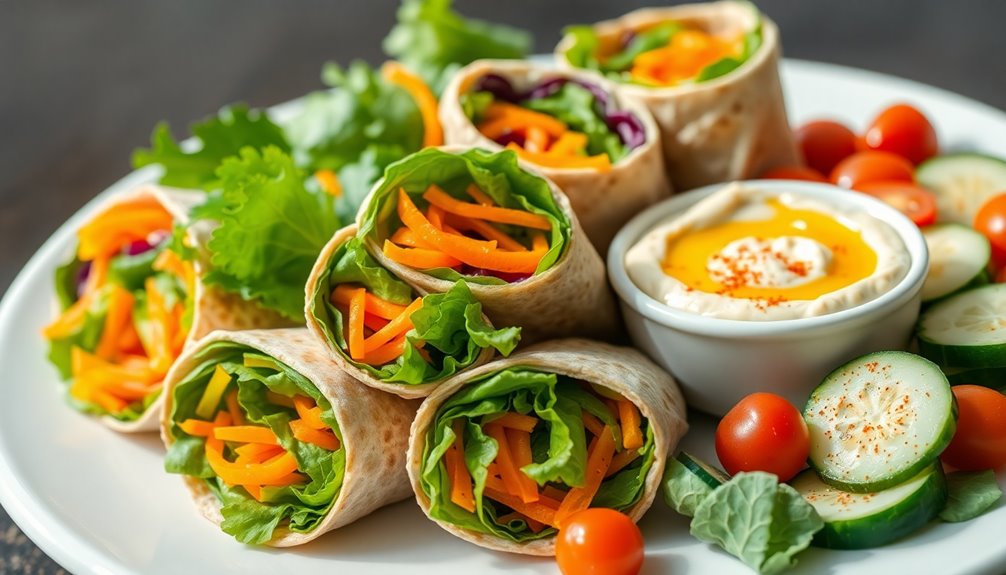
When serving veggie wraps, consider pairing them with complementary sides to enhance the overall meal experience. The right accompaniments not only elevate the flavors but also create a visually appealing presentation. Here are some pairing options and garnish ideas to inspire your meal.
| Pairing Options | Garnish Ideas |
|---|---|
| Fresh fruit salad | Sprinkle of sesame seeds |
| Crunchy vegetable chips | Fresh herbs (like cilantro) |
| Quinoa salad | Drizzle of balsamic glaze |
| Roasted sweet potatoes | Lemon zest |
| Mixed greens with vinaigrette | Edible flowers |
Incorporating these sides introduces delightful flavor combinations that complement your veggie wraps. For instance, a fresh fruit salad pairs wonderfully with the earthy tones of hummus, while crunchy vegetable chips add texture to your plate. Quinoa salad not only boosts nutrition but also serves as a hearty side.
When it comes to presentation tips, consider using colorful plates and arranging your veggie wraps alongside the sides for an inviting display. Garnishing with fresh herbs or a sprinkle of seeds can make your meal feel special and thought-out.
Storage and Meal Prep
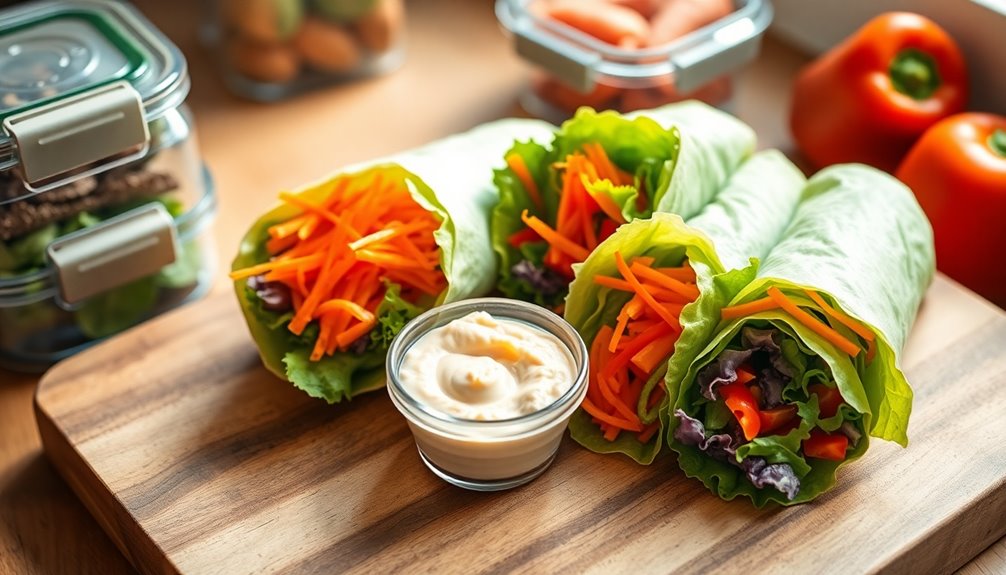
Wondering how to keep your veggie wraps fresh and delicious? Proper storage and meal prep can greatly enhance the longevity of wraps, allowing you to enjoy them throughout the week. To start, make ahead by prepping your ingredients in advance. Wash and chop the veggies, and store them in airtight containers in the fridge. This way, when you're ready to assemble your wraps, you can do it quickly without feeling rushed.
When assembling your wraps, be mindful of layering. Spread hummus evenly across the wrap, then add your veggies and any other fillings. Roll them tightly but not excessively to avoid squishing the ingredients.
After wrapping, you can either enjoy them right away or store them for later. If you're keeping them for a few days, wrap each one in parchment paper or foil. This prevents them from drying out and keeps them fresh.
For best freshness, try to consume your veggie wraps within 3-5 days. If you notice any wilting or browning, it's a sign they're past their prime. If you want to extend the life of your wraps even further, you can freeze them. Just be aware that while freezing can maintain the nutritional value, the texture may change once thawed.
Variations for Dietary Needs
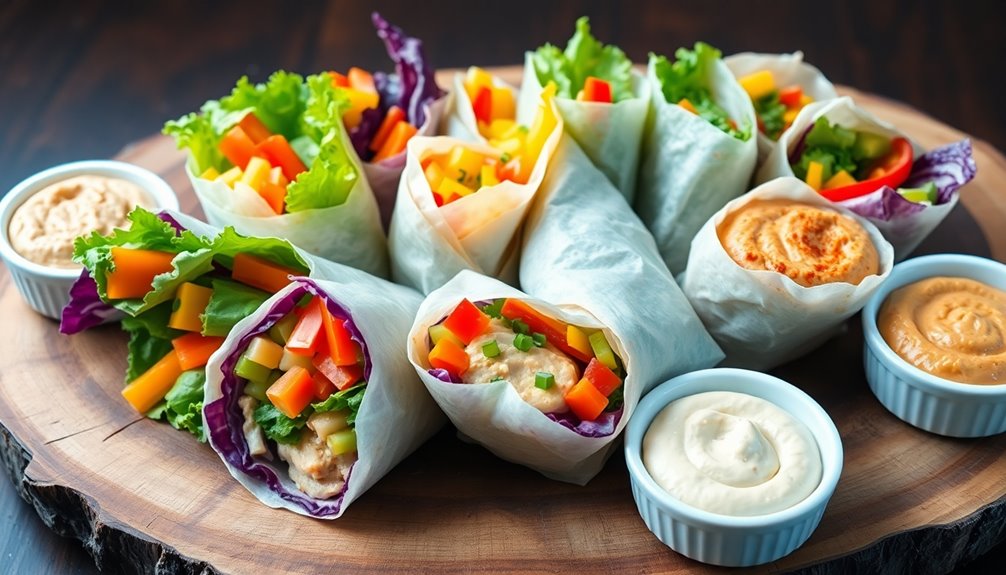
Veggie wraps can easily accommodate a variety of dietary needs, making them a versatile option for everyone. Whether you're navigating gluten intolerances, seeking low carb alternatives, or following a vegan lifestyle, you can create a wrap that suits your preferences without sacrificing flavor or nutrition.
For those needing gluten free options, simply swap out traditional wraps for gluten-free tortillas or large lettuce leaves. This not only keeps your meal safe but also adds a satisfying crunch.
If you're watching your carbohydrate intake, contemplate using a low carb tortilla or even collard greens as a wrap base. These alternatives provide the same satisfaction while helping you maintain your dietary goals.
If you're vegan, there are plenty of adaptations to ponder. You can use hummus as a spread, packed with protein and flavor. Add a variety of colorful vegetables like bell peppers, cucumbers, and carrots for texture and nutrients.
For dairy free modifications, skip any cheese and opt for avocado or a nut-based spread for creaminess.
Frequently Asked Questions
Can I Use Gluten-Free Wraps for Veggie Wraps?
Yes, you can definitely use gluten-free wraps for your veggie wraps. They provide a great base for all your favorite fillings. Consider adding vegan protein options like chickpeas or lentils to boost nutrition. Pair them with flavorful hummus spreads for added taste and creaminess.
This way, you're not just enjoying a meal, but also embracing a delicious, inclusive option that caters to various dietary needs while still being satisfying and nutritious.
How Long Do Veggie Wraps Last in the Fridge?
Imagine biting into a rainbow of flavors, only to find your veggie wraps have turned into a sad, soggy mess! To avoid that tragedy, store your wraps in airtight containers or tightly wrap them in plastic. They generally last about 3 to 5 days in the fridge. Remember, the fresher they are, the better they taste! Follow these storage tips to maximize their shelf life and enjoy your delicious creations longer.
Are Veggie Wraps Suitable for Kids?
Veggie wraps can be great kid-friendly options! They're packed with nutritional benefits, providing essential vitamins and minerals.
You can customize them with colorful veggies, making them visually appealing for kids. Plus, you might find that kids enjoy the crunch and variety.
By incorporating whole grains and healthy dips, you create a balanced meal that's fun to eat.
What Types of Veggies Work Best in Wraps?
When it comes to wraps, the right veggies can turn a simple meal into a taste explosion!
You can't go wrong with crisp leafy greens for that invigorating crunch.
Bell peppers add vibrant colors and a sweet kick, while cucumbers bring that satisfying juiciness.
Don't forget carrots for a hint of earthiness!
Together, these veggies create a delightful medley that's not just healthy but also makes you feel like part of a culinary adventure!
Can I Freeze Veggie Wraps for Later Use?
Yes, you can freeze veggie wraps for later use! For best results, use proper freezing techniques like wrapping them tightly in plastic wrap or foil. This helps maintain flavor variations and prevents freezer burn, extending their shelf life.
When prepping, consider adding ingredients that freeze well, like firm vegetables. Just remember to thaw them in the fridge overnight before enjoying them again.
These simple tips guarantee your wraps stay delicious and satisfying!
Conclusion
Incorporating veggie wraps with hummus into your meals not only boosts your nutrient intake but also adds vibrant flavors to your diet. By choosing fresh ingredients, experimenting with different types of hummus, and exploring creative fillings, you can transform simple wraps into exciting dishes. Whether you're meal prepping for the week or seeking quick snacks, veggie wraps offer versatility and satisfaction. Embrace this healthy option, enjoy its benefits, and make it a regular part of your culinary routine.

